- Joined
- Feb 2, 2011
- Messages
- 2,093
NEW RELEASES FOR NOVEMBER 2021
THE FUR TRADE
MOUNTAIN MEN – THE RENDEZVOUS
A mountain man was an explorer who lived in the wilderness. They were instrumental in opening up the various Emigrant Trails (widened into wagon roads) allowing Americans in the east to settle the new territories of the far west by organized wagon trains traveling over roads explored and in many cases, physically improved by the mountain men and the big fur companies originally to serve the mule train based inland fur trade.
Mountain men were most common in the North American Rocky Mountains from about 1810 through to the 1880s (with a peak population in the early 1840s). Approximately 3,000 mountain men ranged the mountains between 1820 and 1840, the peak beaver-harvesting period. While there were many free trappers, most mountain men were employed by major fur companies. The life of a company man was almost militarized. The men had mess groups, hunted and trapped in brigades and always reported to the head of the trapping party.
This man was called a "boosway", a bastardization of the French term bourgeois. He was the leader of the brigade and the head trader.
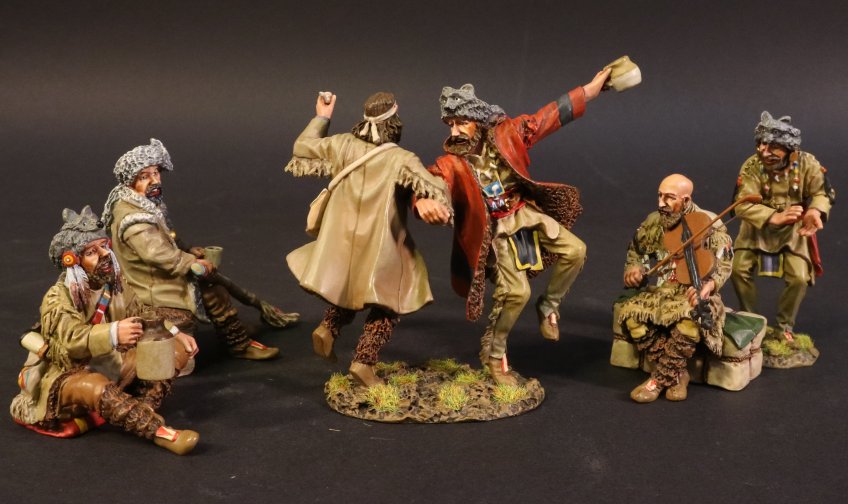
THE ROCKY MOUNTAIN RENDEZVOUS
The Rendezvous was an annual gathering, at various locations held by a fur trading company at which trappers and mountain men sold their furs and hides and replenished their supplies.
The large fur companies put together teamster driven mule trains which packed in whiskey and supplies into a pre-announced location each spring/summer and set up a trading fair- the Rendezvous.
These Rendezvous were known to be lively, joyous places, where all were welcome, fur trappers, Indians, native trapper wives, and children, travellers and later on even tourists who would venture from as far as Europe to observe the festivities.
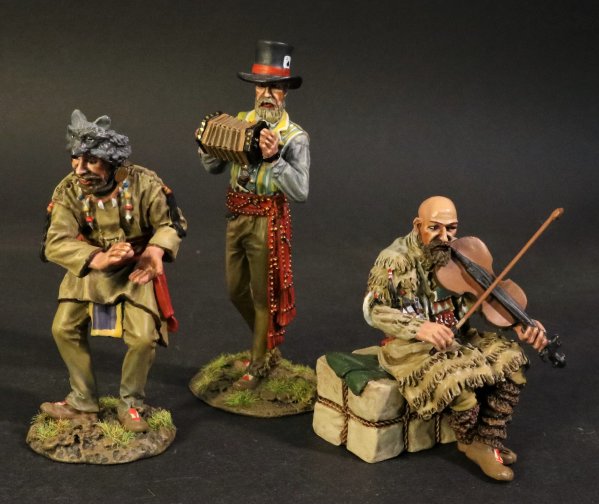
WSP-52
THE FUR TRADE,
THE ROCKY MOUNTAIN RENDEZVOUS,
THE GREEN RIVER VALLEY BOYS.
RUPERT “NIGHTINGALE” AXELSON, BILL “STOVEPIPE” WILLIAMS, AND CUMBERLAND JEFFERS.
A Special thank you to Mike Estell and the JJDESIGNS COLLECTORS CLUB FACEBOOK GROUP, for naming the band and the band members!
WINNERS of the “NAME THE BAND” competition back in January were, STEVE AULT, ROBERTO CAPRA, GARY CLEVENGER and MICHAEL MILLER.
Many thanks to all who entered.
THE BLACKFOOT
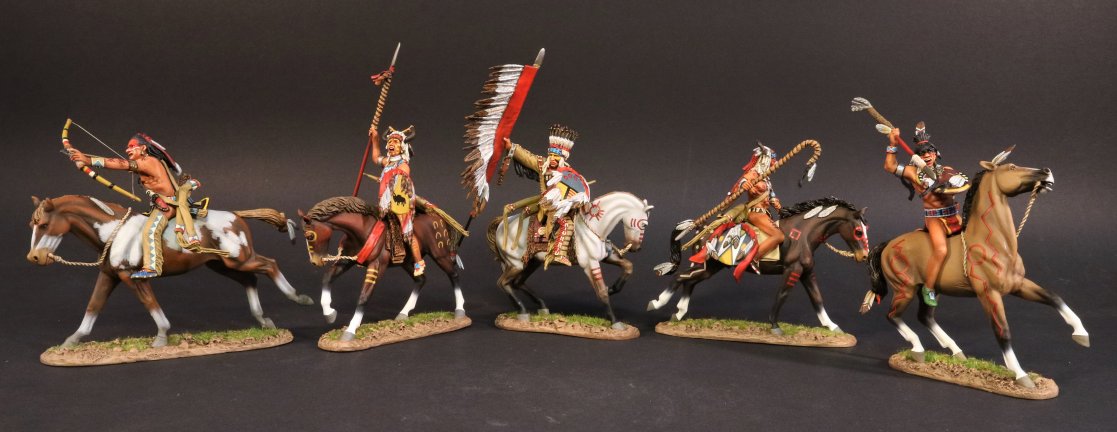
The Niitsiapi, also known as the Blackfoot or Blackfeet Indians, were found in the Great Plains of Montana and the Canadian provinces of Alberta and Saskatchewan.
Only one of the Niitsitapi tribes were called Blackfoot, or Siksika.
The name is said to have come from the colour of the peoples’ moccasins.
It is believed that the leather used to make the moccasins came from the soot-stained leather at the top of the wigwam.
Others believe they had dyed or painted the soles of their moccasins black.
One legendary story claimed that the Siksika walked through ashes of prairie fires, which in turn colored the bottoms of their moccasins black.
Historically, the member peoples of the Blackfoot Confederacy were nomadic bison hunters and trout fishermen, who ranged across large areas of the northern Great Plains of western north America. They followed the bison herds as they migrated between what are now the United States and Canada, as far north as the Bow River.
In the first half of the eighteenth century, they acquired horses and firearms from white traders and their Cree and Assiniboine go-betweens. The Blackfoot used these to expand their territory at the expense of neighbouring tribes.
They eventually became a formidable example of the classic Plains Indian culture. They were a powerful force, controlling an area that extended from current day Edmonton, Alberta Province, nearly to Yellowstone Park, and from Glacier Park to the Black Hills of South Dakota.
The Badger-Two Medicine Area is a significant sacred site for the tribe.
Up until around 1730, the Blackfoot traveled by foot and used dogs to carry and pull goods. They had not seen horses, but were introduced to them on the Plains as other tribes, such as the Shoshone, had already adopted their use. The Blackfoot called the horses Ponokamita (elk dogs). The horses could carry much more weight than dogs and moved at greater speed, and they could be ridden for hunting and travel.
Horses revolutionized life on the Great Plains and soon became to be regarded as a measure of wealth.
Warriors regularly raided other tribes for their best horses, and were generally used as universal standards of barter.
Medicine men were paid for cures and healing with horses, and those who designed shields and war bonnets were also paid in horses.
The individual’s prestige and status was judged by the number of horses that he could give away.
Blackfoot war parties would ride hundreds of miles on raids.
A boy on his first war party was given a derogatory name, but after he had stolen his first horse or killed an enemy, he was given a name to honour him.
Warriors would strive to perform various acts of bravery called “counting coup”, in order to move up in social rank.
The coups in order of importance were;
Taking a gun from a living enemy, and or touching him directly, capturing lances, and bows, scalping an enemy, killing an enemy, freeing a tied horse from in front of an enemy lodge, leading a war party, scouting for a war party, stealing headdresses, shields, pipes (sacred ceremonial pipes) and driving a herd of stolen horses back to camp.
In subsequent years, mountain men trapping in Blackfoot country generally encountered hostility.
When John Colter, a member of the Lewis and Clarke expedition, returned to Blackfoot country, he barely escaped with his life!
In 1809, Colter and his companion were trapping on the Jefferson River, by canoe when they were surrounded by Blackfoot warriors. Colter’s companion John Potts, did not surrender and was killed. Colter was stripped of his clothes and forced to run for his life, after being given a head start (which famously became known in the annals of the West as Colter’s Run). He eventually escaped by reaching a river five miles away and diving under either an island of driftwood or a beaver dam, where he remained concealed until nightfall.
He then trekked another 300 miles to a fort.
Like many other Great Plains Indian nation, the Niitsitapi often had hostile relationships with white settlers. Despite the hostilities, the Blackfoot stayed largely out of the Great Plains Indian Wars, neither fighting against nor scouting for the United States army.
When the Lakota, Cheyenne and Arapaho were fighting the United States army, they sent runners into Blackfoot territory, urging them to join the fight.
Crowfoot, one of the most influential Blackfoot chiefs, dismissed the messengers and threatened to ally with the NWMP to fight them if they came north into Blackfoot country.
News of Crowfoot’s loyalty reached Ottawa and from there to London. Queen Victoria praised Crowfoot and the Blackfoot for their loyalty.
The Blackfoot also chose to stay out of the Northwest Rebellion. News of the continued neutrality reached Ottawa, where Lord Lansdowne the governor general, expressed his thanks to Crowfoot again on behalf of the Queen back in London.
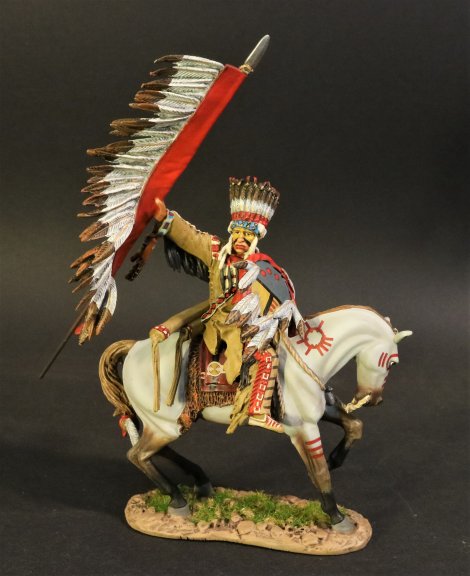
WSP-30
THE FUR TRADE,
THE BLACKFOOT,
BLACKFOOT CHIEF WITH WARFLAG
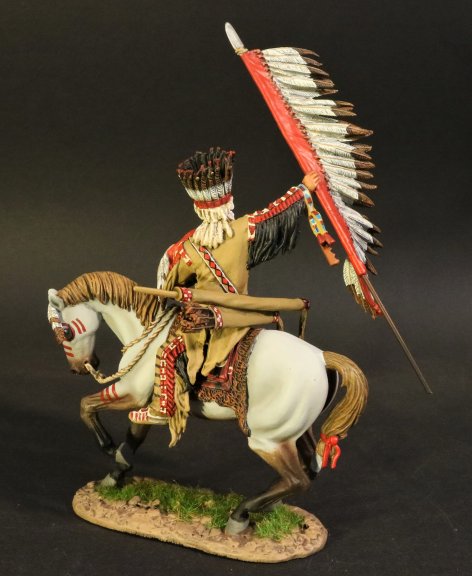
THE FUR TRADE
MOUNTAIN MEN – THE RENDEZVOUS
A mountain man was an explorer who lived in the wilderness. They were instrumental in opening up the various Emigrant Trails (widened into wagon roads) allowing Americans in the east to settle the new territories of the far west by organized wagon trains traveling over roads explored and in many cases, physically improved by the mountain men and the big fur companies originally to serve the mule train based inland fur trade.
Mountain men were most common in the North American Rocky Mountains from about 1810 through to the 1880s (with a peak population in the early 1840s). Approximately 3,000 mountain men ranged the mountains between 1820 and 1840, the peak beaver-harvesting period. While there were many free trappers, most mountain men were employed by major fur companies. The life of a company man was almost militarized. The men had mess groups, hunted and trapped in brigades and always reported to the head of the trapping party.
This man was called a "boosway", a bastardization of the French term bourgeois. He was the leader of the brigade and the head trader.

THE ROCKY MOUNTAIN RENDEZVOUS
The Rendezvous was an annual gathering, at various locations held by a fur trading company at which trappers and mountain men sold their furs and hides and replenished their supplies.
The large fur companies put together teamster driven mule trains which packed in whiskey and supplies into a pre-announced location each spring/summer and set up a trading fair- the Rendezvous.
These Rendezvous were known to be lively, joyous places, where all were welcome, fur trappers, Indians, native trapper wives, and children, travellers and later on even tourists who would venture from as far as Europe to observe the festivities.

WSP-52
THE FUR TRADE,
THE ROCKY MOUNTAIN RENDEZVOUS,
THE GREEN RIVER VALLEY BOYS.
RUPERT “NIGHTINGALE” AXELSON, BILL “STOVEPIPE” WILLIAMS, AND CUMBERLAND JEFFERS.
A Special thank you to Mike Estell and the JJDESIGNS COLLECTORS CLUB FACEBOOK GROUP, for naming the band and the band members!
WINNERS of the “NAME THE BAND” competition back in January were, STEVE AULT, ROBERTO CAPRA, GARY CLEVENGER and MICHAEL MILLER.
Many thanks to all who entered.
THE BLACKFOOT

The Niitsiapi, also known as the Blackfoot or Blackfeet Indians, were found in the Great Plains of Montana and the Canadian provinces of Alberta and Saskatchewan.
Only one of the Niitsitapi tribes were called Blackfoot, or Siksika.
The name is said to have come from the colour of the peoples’ moccasins.
It is believed that the leather used to make the moccasins came from the soot-stained leather at the top of the wigwam.
Others believe they had dyed or painted the soles of their moccasins black.
One legendary story claimed that the Siksika walked through ashes of prairie fires, which in turn colored the bottoms of their moccasins black.
Historically, the member peoples of the Blackfoot Confederacy were nomadic bison hunters and trout fishermen, who ranged across large areas of the northern Great Plains of western north America. They followed the bison herds as they migrated between what are now the United States and Canada, as far north as the Bow River.
In the first half of the eighteenth century, they acquired horses and firearms from white traders and their Cree and Assiniboine go-betweens. The Blackfoot used these to expand their territory at the expense of neighbouring tribes.
They eventually became a formidable example of the classic Plains Indian culture. They were a powerful force, controlling an area that extended from current day Edmonton, Alberta Province, nearly to Yellowstone Park, and from Glacier Park to the Black Hills of South Dakota.
The Badger-Two Medicine Area is a significant sacred site for the tribe.
Up until around 1730, the Blackfoot traveled by foot and used dogs to carry and pull goods. They had not seen horses, but were introduced to them on the Plains as other tribes, such as the Shoshone, had already adopted their use. The Blackfoot called the horses Ponokamita (elk dogs). The horses could carry much more weight than dogs and moved at greater speed, and they could be ridden for hunting and travel.
Horses revolutionized life on the Great Plains and soon became to be regarded as a measure of wealth.
Warriors regularly raided other tribes for their best horses, and were generally used as universal standards of barter.
Medicine men were paid for cures and healing with horses, and those who designed shields and war bonnets were also paid in horses.
The individual’s prestige and status was judged by the number of horses that he could give away.
Blackfoot war parties would ride hundreds of miles on raids.
A boy on his first war party was given a derogatory name, but after he had stolen his first horse or killed an enemy, he was given a name to honour him.
Warriors would strive to perform various acts of bravery called “counting coup”, in order to move up in social rank.
The coups in order of importance were;
Taking a gun from a living enemy, and or touching him directly, capturing lances, and bows, scalping an enemy, killing an enemy, freeing a tied horse from in front of an enemy lodge, leading a war party, scouting for a war party, stealing headdresses, shields, pipes (sacred ceremonial pipes) and driving a herd of stolen horses back to camp.
In subsequent years, mountain men trapping in Blackfoot country generally encountered hostility.
When John Colter, a member of the Lewis and Clarke expedition, returned to Blackfoot country, he barely escaped with his life!
In 1809, Colter and his companion were trapping on the Jefferson River, by canoe when they were surrounded by Blackfoot warriors. Colter’s companion John Potts, did not surrender and was killed. Colter was stripped of his clothes and forced to run for his life, after being given a head start (which famously became known in the annals of the West as Colter’s Run). He eventually escaped by reaching a river five miles away and diving under either an island of driftwood or a beaver dam, where he remained concealed until nightfall.
He then trekked another 300 miles to a fort.
Like many other Great Plains Indian nation, the Niitsitapi often had hostile relationships with white settlers. Despite the hostilities, the Blackfoot stayed largely out of the Great Plains Indian Wars, neither fighting against nor scouting for the United States army.
When the Lakota, Cheyenne and Arapaho were fighting the United States army, they sent runners into Blackfoot territory, urging them to join the fight.
Crowfoot, one of the most influential Blackfoot chiefs, dismissed the messengers and threatened to ally with the NWMP to fight them if they came north into Blackfoot country.
News of Crowfoot’s loyalty reached Ottawa and from there to London. Queen Victoria praised Crowfoot and the Blackfoot for their loyalty.
The Blackfoot also chose to stay out of the Northwest Rebellion. News of the continued neutrality reached Ottawa, where Lord Lansdowne the governor general, expressed his thanks to Crowfoot again on behalf of the Queen back in London.

WSP-30
THE FUR TRADE,
THE BLACKFOOT,
BLACKFOOT CHIEF WITH WARFLAG


